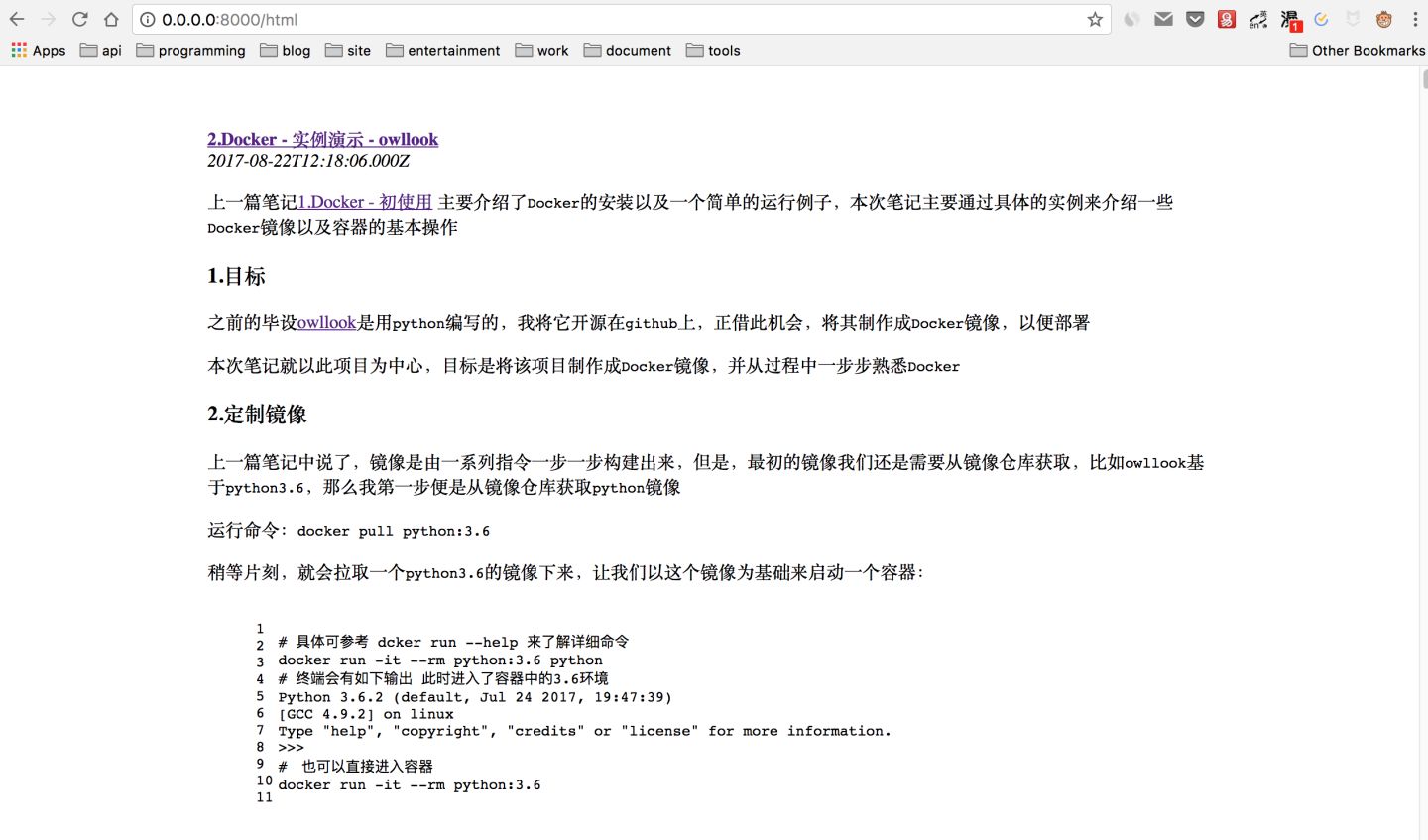一个项目,在最外层他们应该是一样的,至少需要有:
| 文件夹 |
说明 |
| docs |
项目文档说明 |
| src/pro_name |
项目名称 |
| tests |
测试用例 |
| README.md |
项目介绍 |
| requirements.txt |
该项目依赖的第三方库 |
| …… |
…… |
那接下来需要讨论的,就是 src 的内部结构该是什么样的呢?
本章将写一个 rss 解析展示的项目用做演示。
2.1.普通的项目结构
一个普通的项目:
- 不需要添加后续模块功能
- 快速开发使用,不需要维护
- 无较复杂的前端需求
- 用完就走
那么就可以像 demo01 中一样,只需要添加一个 run.py 或者叫做 app.py 文件(反正这是一个启动文件,命名可随意),不论是配置、路由都写在一起就好了。
新建一个项目如下:
1
2
3
4
5
6
7
8
|
sample01
├── docs
│ └── demo.md
├── src
│ └── run.py
├── tests
├── .gitignore
└──requirements.txt
|
任意一个 rss 源,假设项目需要将其中的文章标题以及链接提取并展示出来,比如以json格式返回,这属于很简单的功能,可以说只有一段逻辑,run.py 内容如下:
1
2
3
4
5
6
7
8
9
10
11
12
13
14
15
16
17
18
19
20
21
|
#!/usr/bin/env python
from sanic import Sanic
from sanic.response import json
from feedparser import parse
app = Sanic()
@app.route("/")
async def index(request):
url = "http://blog.howie6879.cn/atom.xml"
feed = parse(url)
articles = feed['entries']
data = []
for article in articles:
data.append({"title": article["title_detail"]["value"], "link": article["link"]})
return json(data)
if __name__ == "__main__":
app.run(host="0.0.0.0", port=8000)
|
访问 http://0.0.0.0:8000/,会返回一串json,如下:

接下来,问题升级,我想要将标题链接用页面展示,该怎么弄?
我们需要一个页面模板,然后写入json数据,最后用 jinja2 的 template 将其渲染:
1
2
3
4
5
6
7
8
9
10
11
12
13
14
15
16
17
18
19
20
21
22
23
24
25
26
27
28
29
30
31
32
33
34
35
36
|
# template的渲染模板
# 后面会使用更方便的模板引用方式
template = Template(
"""
<!DOCTYPE html>
<html lang="en">
<head>
<meta charset="UTF-8">
<title>rss阅读</title>
<meta name="viewport" content="width=device-width, initial-scale=1">
</head>
<body>
<article class="markdown-body">
{% for article in articles %}
<b><a href="{{article.link}}">{{article.title}}</a></b><br/>
<i>{{article.published}}</i><br/>
<hr/>
{% endfor %}
</article>
</body>
</html>
"""
)
# 逻辑函数
@app.route("/html")
async def rss_html(request):
url = "http://blog.howie6879.cn/atom.xml"
feed = parse(url)
articles = feed['entries']
data = []
for article in articles:
data.append(
{"title": article["title_detail"]["value"], "link": article["link"], "published": article["published"]})
html_content = template.render(articles=data)
return html(html_content)
|
具体结构代码见sample01,运行起来,然后输入 http://0.0.0.0:8000/html 就可以看到被展示出来的页面^_^

假设需要编写前端页面比较多,那么你就需要添加static 以及 templates 文件夹用来管理各个界面模块,具体下面会介绍。
2.2.项目结构具体说明
当编写的项目过于复杂,我都会将其当做一个第三方包来管理项目中涉及的各种模块,比如 owllook,目录下面你会发现有个 __init__.py 文件,它初始化了当前目录下的应用,然后代码中引用某个函数可以这么写:
1
|
from owllook.config import Config
|
每个项目的内部分布以及命名可能不一样(甚至目录比应该或多或少),但大体意思可能差不多,下面介绍本次项目 src 下的一些文件目录结构:
1
2
3
4
5
6
7
8
9
10
11
12
|
sample02
├── docs
│ └── demo.md
├── src
│ ├── config # 配置
│ ├── static # css、js、img
│ ├── templates # Jinja2模板
│ └── views # 路由、逻辑处理
│ ├── __init__.py
│ ├── run.py # 启动文件
├── tests
└── requirements.txt
|
此处就可以将 sample02 当成一个包了,咱们来试试看:
首先新建文件 /views/rss.py :
1
2
3
4
5
6
7
8
9
10
11
12
13
14
15
16
17
18
19
20
21
22
23
24
25
26
27
|
enable_async = sys.version_info >= (3, 6)
app = Sanic()
# jinjia2 config
env = Environment(
loader=PackageLoader('views.rss', '../templates'),
autoescape=select_autoescape(['html', 'xml', 'tpl']),
enable_async=enable_async)
async def template(tpl, **kwargs):
template = env.get_template(tpl)
rendered_template = await template.render_async(**kwargs)
return html(rendered_template)
@app.route("/html")
async def rss_html(request):
url = "http://blog.howie6879.cn/atom.xml"
feed = parse(url)
articles = feed['entries']
data = []
for article in articles:
data.append(
{"title": article["title_detail"]["value"], "link": article["link"], "published": article["published"]})
return await template('rss.html', articles=articles)
|
这里使用异步的方式引入了 jinja2 ,需要注意的是python版本必须3.6+,否则就得使用同步的方式来引入 jinja2 ,后面章节会继续介绍。
此时启动文件 run.py 只要引入 /views/rss.py 的 app 实例即可:
1
2
3
4
5
6
7
8
9
10
11
12
|
# !/usr/bin/env python
import sys
import os
sys.path.append(os.path.dirname(os.path.dirname(os.path.abspath(__file__))))
from src.views import app
from src.config import CONFIG
app.static('/static', CONFIG.BASE_DIR + '/static')
if __name__ == "__main__":
app.run(host="0.0.0.0", port=8000)
|
还有一些css文件这里就不介绍,具体代码请看sample02,运行起来,然后输入 http://0.0.0.0:8000/html 就好,效果如下图:

2.3.说明
关于 views templates static 内部的构造也是值得一些,这就涉及到蓝图 Blueprint ,后面介绍蓝图的时候会进行介绍。
代码地址:demo03



